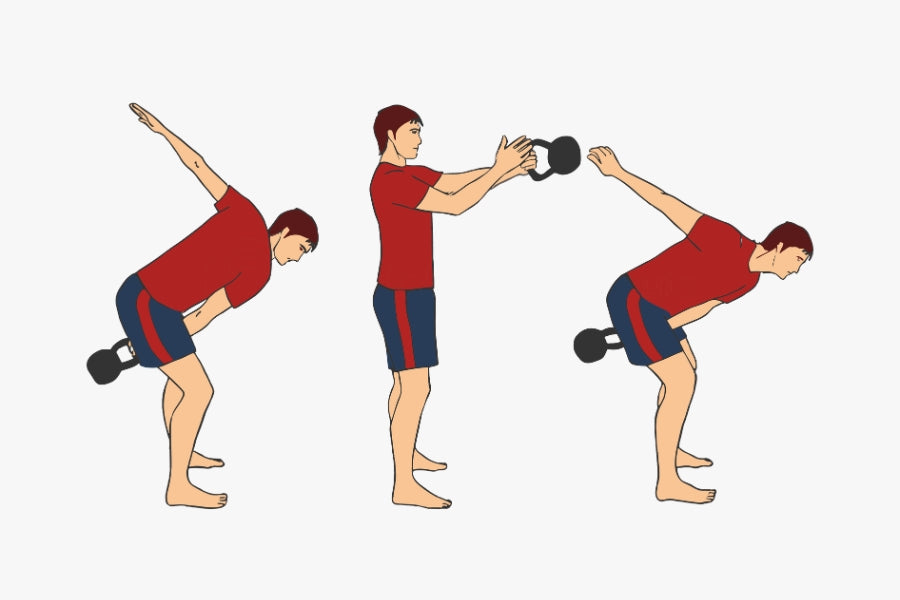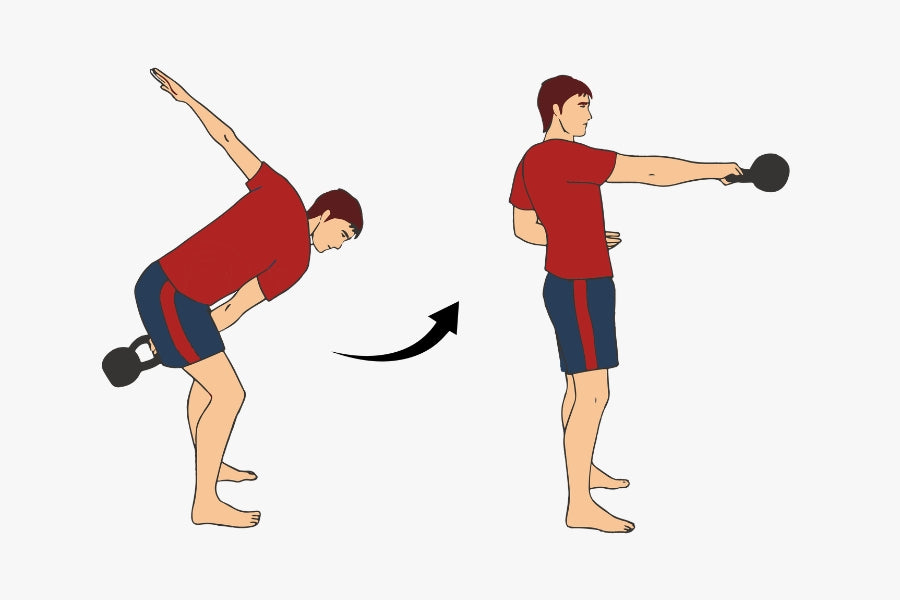The kettlebell swing stands as a dynamic, full-body exercise that combines strength, cardiovascular conditioning, and flexibility.
It is a well-known exercise because it activates multiple muscle groups at a time, making it an unparalleled calorie burner and strength enhancer.
Adding Kettlebell Swings into your workout is a great choice, but learning to do it properly is a must to get the results apt to your goals.
Whether you are trying to burn calories or gain strength, this is a perfect exercise you can do without having to go to the gym.
But here’s a thing to ponder upon: kettlebell weights should be chosen according to the fitness level of a person to avoid any injury.
In this article, you will learn everything about kettlebell swings: the muscles worked, variations, proper form, and their adaptability to your fitness level.
So, let’s get started:
Kettlebell Swing Muscles Worked
Kettlebell Swings is a compound exercise that targets multiple muscles at a time, giving the body the perfect shape and stamina.
The primary muscles worked during kettlebell swings include:
|
Muscles Worked |
Role in Kettlebell Swings |
|
Glutes and Hamstrings |
Support the hip hinge movement |
|
Quadriceps |
Engage during hip extension and standing |
|
Core Muscles |
Stabilize the spine during swinging motion |
|
Latissimus Dorsi |
Work during kettlebell pull in the swing |
|
Forearms and Grip Muscles |
Enhance grip strength during kettlebell handling. |
Engaging all these muscle groups simultaneously makes kettlebell swings an effective full-body exercise, promoting strength, power, and endurance.
FYI: Proper form is essential to ensure that these muscles are activated optimally while minimising the risk of injury.
How To Do Kettlebell Swings The Right Way?

The most important part of adopting any exercise is to do it properly to get the most benefits of it.
Following are some steps to do the kettlebell swing workout the right way:
- Stand with your feet shoulder-width apart, toes pointing slightly outward
- Place the kettlebell about a foot in front of you
- Bend at the hips and knees, keeping your back straight
- Grasp the kettlebell handle with both hands
- Push your hips back while maintaining a slight bend in the knees
- Swing the kettlebell back between your legs, it shouldn't go below your knees.
- At the top of the swing, stand tall with your hips fully extended
- The kettlebell should reach about chest height.
- Allow the kettlebell to swing back between your legs in a controlled manner.
FYI: Start with lighter kettlebell weights to ensure proper form before progressing to heavier kettlebells.
Benefits For Glute Strength, Improved Posture & Fat Burn

Kettlebell Swing benefits are tremendous. It engages your entire body and transforms it completely.
This one exercise is enough to give you an amazing-looking body. Let’s see some of the benefits of kb swing for your body:
1. Cardiovascular Endurance
The dynamic, rhythmic nature of kettlebell swings elevates the heart rate.
In this way, this exercise gives an effective cardiovascular workout and enhances endurance over time.
2. Calories Burn
Kettlebell swings are a high-intensity exercise that demands energy, making them an efficient calorie-burning workout.
Doing a kettlebell swing regularly helps you lose weight and burn more fat than a usual workout.
3. Core Activation

Kettlebell swings are effective for dynamic core activation through their unique movement patterns.
The explosive hip thrust in kettlebell swings requires strong core engagement, effectively working the abdominal muscles and promoting core stability.
4. Functional Strength
Kettlebell swings help to increase the body’s functional strength by mimicking natural movement patterns, such as the hip hinge.
It improves performance in daily activities and sports by enhancing coordination and stability.
5. Improved Posture
Kettlebell swings contribute to improved posture by reinforcing proper body mechanics and strengthening key muscle groups.
It helps stabilise the spine and encourages an upright torso throughout the movement, providing a perfect posture for the body.
6. Increased Flexibility

KB Swings contribute to increased flexibility by engaging the muscles in a dynamic range of motion.
As individuals consistently perform kettlebell swings, this dynamic movement pattern helps improve flexibility by promoting increased blood flow.
7. Improved Mood
Kettlebell swings contribute to improved mood through a combination of physical exertion and physiological responses.
It prompts the release of endorphins, the body's natural mood enhancers, promoting a sense of well-being and reducing stress.
8. Joint Support
Kettlebell swing involves a hip hinge, encouraging flexion and extension of the hips and knees, which supports joint mobility.
It makes kettlebell swings a valuable exercise for individuals seeking to enhance mobility while minimizing impact on their joints.
9. Mental Focus

Kettlebell swings demand heightened mental focus through the rhythmic coordination of movement and breath.
The repetitive nature of swings encourages mindfulness and increases mental focus in the individuals.
10. Increased Explosiveness
Kettlebell swings engage hip, glute, and core fast-twitch fibers, fostering rapid force production development.
This enhanced explosiveness has practical applications for various activities, such as improving athletic performance.
Break Monotony with Kettlebell Swing Variations

If you get tired of doing one exercise repeatedly, you can try variations of it to add a little bit of fun to your workout routine.
In the same way, there is no need to do traditional kettlebell swings again and again.
Here are some variations that you can do to make this exercise more interesting:
1. Russian Kettlebell Swing

Russian KB swings is an effective full-body exercise that originated from traditional Russian training methods.
Why Russian Kettlebell Swing?
It's a fantastic workout for improving strength, endurance, and overall fitness.
This exercise is particularly beneficial for those seeking a time-effective workout.
How to do it
- Place kettlebell between feet
- Stand with feet shoulder-width apart
- Hinge at hips, grab kettlebell with both hands
- Thrust hips forward, swing kettlebell to chest height
- Allow kettlebell to swing back between legs
- Repeat the controlled swinging motion.
2. American Kettlebell Swing
American Kettlebell Swings is a dynamic exercise that elevates the traditional Russian swing by incorporating an overhead extension.
Why American Kettlebell Swing?
American kettlebell swings offer a unique twist, targeting additional muscle groups and enhancing overall functional fitness.
How to do it
- Place the kettlebell on the ground between your feet
- Stand with feet shoulder-width apart
- Hinge at the hips, and grab the kettlebell with both hands
- Thrust your hips forward, swinging the kettlebell forward and upward
- At the peak of the swing, bring the kettlebell in line with your head
- Repeat the swinging motion with the desired number of repetitions.
3. Alternating Kettlebell Swing

Alternating kettlebell swings is a variation of traditional kettlebell swings, targeting both sides of the body independently.
Why Alternating Kettlebell Swing?
It enhances coordination and engages different muscle groups, offering a well-rounded workout for strength and balance.
How to do it
- Place a kettlebell on the ground between your feet
- Stand with feet shoulder-width apart
- Hinge at the hips, and grab the kettlebell with one hand
- Thrust your hips forward, swinging the kettlebell forward and upward
- As the kettlebell reaches its peak, switch hands in mid-air
- Allow the kettlebell to swing back between your legs
- Switch hands again at the bottom of the swing
- Continue for the desired number of repetitions.
4. Single Arm Kettlebell Swing

Single-arm kettlebell swings introduce a unilateral aspect to the traditional swing, focusing on one arm at a time.
Why Single Arm Kettlebell Swing?
Single-arm kettlebell swings help address asymmetry in strength and coordination between the left and right sides of the body.
How to do it
- Place a kettlebell on the ground between your feet
- Stand with feet shoulder-width apart
- Hinge at the hips, and grab the kettlebell with one hand
- Thrust your hips forward, swinging the kettlebell forward and upward
- Allow the kettlebell to swing back between your legs
- Continue the swinging motion for the desired number of repetitions.
5. Double Kettlebells Swing

Double kettlebell swings elevate the intensity by incorporating two kettlebells simultaneously.
Why Double Kettlebells Swing?
This advanced variation boosts strength, power, and coordination, offering a challenging yet rewarding workout for those pushing fitness limits.
How to do it
- Place two kettlebells on the ground between your feet
- Stand with feet shoulder-width apart
- Hinge at the hips, and grab both kettlebells with both hands
- Thrust your hips forward, swinging both kettlebells forward and upward
- Allow the kettlebells to swing back between your legs
- Continue for the desired number of repetitions.
6. Lateral Kettlebell Swing

Lateral kettlebell swings provide a fresh perspective on traditional swings, activating muscles in a lateral plane.
Why Lateral Kettlebell Swing?
This exercise enhances core stability, works the muscles from different angles, and offers a fun variation to spice up your workout routine.
How to do it
- Place a kettlebell on the ground between your feet
- Stand with feet slightly wider than shoulder-width apart
- Hinge at the hips, and grab the kettlebell with both hands
- Explosively thrust your hips forward, swinging the kettlebell to the side
- Alternate sides with each swing, maintaining control
- Allow the kettlebell to swing back between your legs after each lateral swing
- Continue the motion for the desired number of repetitions.
7. Dead Stop Kettlebell Swing
The Dead Stop Kettlebell Swing introduces a brief pause at the bottom of each swing, enhancing control and power.
Why Dead Stop Kettlebell Swing?
This variation provides a unique challenge, emphasizing explosive hip drive and promoting better muscle engagement for a comprehensive workout.
How to do it
- Place the kettlebell on the ground between your feet
- Stand with feet shoulder-width apart
- Hinge at the hips, and grab the kettlebell with both hands
- The kettlebell should be between your legs, with arms fully extended
- Thrust your hips forward, swinging the kettlebell forward and upward
- Pause at the bottom, letting the kettlebell come to a complete stop
- Initiate the swing motion again with a powerful hip thrust
- Allow the kettlebell to swing back between your legs, pausing briefly at the bottom
- Repeat for the desired number of repetitions.
8. One Arm Staggered Kettlebell Swing With Rotation
The One Arm Staggered Kettlebell Swing With Rotation combines a staggered stance and rotational movement, adding complexity to the traditional swing.
Why One Arm Staggered Kettlebell Swing?
It enhances overall functional strength, making it particularly beneficial for those aiming to improve stability, balance, and core strength.
How to do it
- Place a kettlebell on the ground slightly in front of you
- Stand with a staggered stance, one foot forward and the other back
- Hinge at the hips, and grab the kettlebell with one hand
- The kettlebell should be between your legs with the arm fully extended
- Thrust your hips forward, swinging the kettlebell forward and upward
- Twist your torso towards the front foot as the kettlebell rises to chest level.
- Allow the kettlebell to swing between your legs, keeping the staggered stance
- Continue the motion for the desired number of repetitions.
Only 13 Tips To Improve Kettlebell Swing Form Completely

Maintaining proper Kettlebell Swing Form is necessary to avoid any injury during the exercise and to do it more effectively.
Following are some tips to improve your form during the Kettle bell swings:
1. Position Your Feet Correctly
Ensure your feet are slightly wider than shoulder-width apart, with toes turned out at around 10 degrees.
Weight should be on the outside and middle to heel of the feet to activate the back and buttocks properly.
Avoid shifting weight to your toes.
2. Hip-Centric Power
Your hips are the powerhouse of the swing.
Crease at the hips with a flat back, actively pushing hips backward and then driving them forward.
Clench your backside for more power, focusing on a vertical position without leaning backward.
3. Maintain a Flat Back
Maintain a straight line from the tail to the shoulders, engaging the posterior chain.
If your back bends, push your hips further backward. The flexibility of your hamstrings determines how far forward you can go.
4. Engage Your Core
Ensure to engage your core effectively throughout the kettlebell swing.
Begin by consciously bracing the abdominal wall to stabilize the spine.
As you perform hip thrusts, contract your abs actively to prevent your hips from extending beyond the center line.
5. Minimize Shoulder Engagement
Shoulders act as a connection; power comes from the hips.
Relax shoulders, and use upper back muscles to keep them in place.
Kettle swings effectively rehabilitate shoulders, strengthening connective tissue.
6. Ensure Proper Neck Alignment
Maintain good neck alignment by focusing on the horizon.
Follow the swing with your head, looking in front of your feet at the bottom. Avoid overextending the neck.
7. Grip Properly
Maintain a relaxed grip; depending on handle width, hold with all fingers or 3 fingers on each hand.
The grip is challenged during swings, especially with a fatter handle.
8. Achieve the Right Height and Depth
Swing comes from the hips, not the lower back or shoulders.
Forward bending from the hips, not the knees.
Monitor height to mid-forearm on the inner thigh, ensuring the shoulders stay behind the toes.
9. Breath Continuously
Light kettlebell – breathe out on the downward phase and in on the upward phase.
Heavier kettlebell – brace your abs, hold your breath momentarily on the downward phase, and breathe out on the upward phase.
10. Take a Strategic Start to the Swing
Two options – start the swing momentum by nudging off your thigh or start directly off the floor.
Nudging ensures an upright position while starting from the ground feels more fluid.
11. Finish with Safety and Control
Finish the swing safely by bringing the kettlebell just in front of the line of your feet. Avoid twisting the upper body.
12. Perfect Your Timing in the Swing
Perfect timing is crucial. Hips should be at their furthest back when the kettlebell is at its lowest point.
Avoid a third bounce or rock at the bottom of the swing.
13. Optimize Power Generation
All power comes from the hips and posterior chain.
Explode forward with the hips, snapping them to vertical for maximum force generation and muscle engagement.
Conclusion
Kettlebell swings are an incredibly effective full-body exercise that offers numerous benefits, including calorie burning and core activation.
These benefits make kettlebell swings a versatile and powerful addition to any fitness routine.
For those looking to enhance their kettlebell workout experience, using kettlebells of the desired weight and good quality is very necessary.
DMoose provides Kettlebells with color-coded options that are made of high quality so that you can choose the best according to your needs.
Whether you're a beginner or an experienced athlete, DMoose provides the tools and resources needed to achieve your fitness goals.
Head to DMoose.com for a safer, more efficient, and enjoyable workout experience.
Related Articles
10 Kettlebell Exercises That Will Tone Your Entire Body
5 Kettlebell Shoulder Workouts That Build Shoulder Strength & Stability
The Best Kettlebell Exercises for At-Home Workouts
Kettlebells – Everything You Need to Know About This Ultimate Exercise Equipment
7 Best Kettlebell Exercises to Start Doing Now As a Beginner








